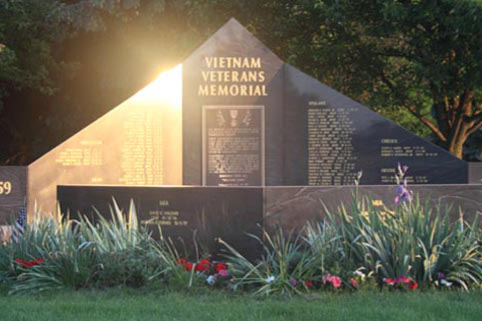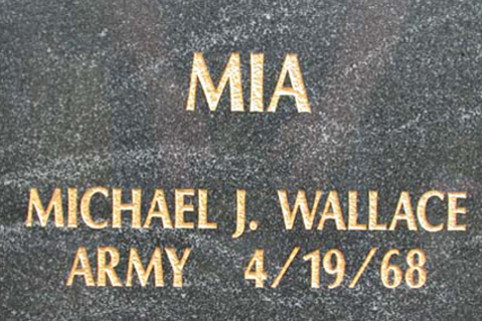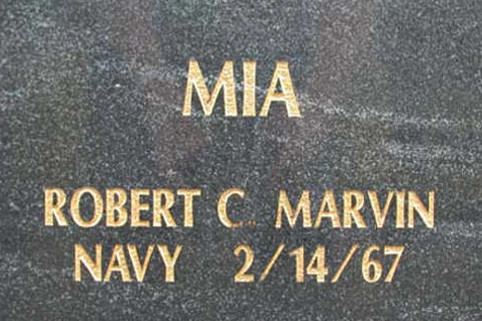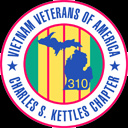This poem says it all and has been included in every ceremony and observance held at the Memorial. Today, the Memorial is used for patriotic observances and events. It serves as a focal point for all Veterans. Family members and friends often visit throughout the year. Township officials report they see people visiting the Memorial at all times of the day and night. School classes make field trip visits and listen to talks about the Memorial, its purpose and meaning.

VVA CHAPTER 310 AND BACKGROUND
There had been a previous attempt to start a local VVA chapter, but they could not get the 35 members required to apply for a charter from the national organization. About a year later, more local Vietnam Veterans began attending the formation meetings. That was 15-20 years after we had returned home from Vietnam. Most Vietnam Veterans were very skeptical about joining any group at that time. Many reported the terrible reception they experienced when trying to join a VFW or American Legion Post. We wondered what VVA could offer us. But what we found was what we had been missing since our service during the Vietnam War. We found a group of proud Veterans who were much like those we had served with during the War. Our Memorial committee members were among the first members of the local VVA Chapter. We got hooked and got involved.
Our Washtenaw County VVA chapter received its charter from the national organization in May of 1987, and since was twice awarded “National Chapter of the Year.” The inauguration ceremony at Riverside Park in Ypsilanti. Former Michigan Governor and World War II Veteran John B. Swainson made the presentation to our VVA President, Tim Armentrout.
Our inauguration day was a beautiful sunny day. Nearby Haab’s restaurant prepared nicely roasted chicken and we had all the trimmings. Everyone enjoyed themselves. Proudly we knew it was the beginning of something special for local Vietnam era Veterans. We were a group of about 35 men and women who had one thing in common. We had proudly served during the Vietnam War. We did not know each other during our military service. But we had a special respect and bond one veteran to another. Only those who were a member of our group of Veterans could understand.
Our side was winning the War when the last of the ground fighting units were pulled out of South Vietnam in 1972. But lacking support from our government, as promised in the Paris Peace agreement, Saigon fell in 1975. It was the reneging D.C. politicians and the anti-war movement who lost that War. But Vietnam Veterans were annointed with the guilt of ‘losing’ it. Upon our return, the loss was placed on our shoulders by our country. We were reminded often about all of the terrible things we supposedly did while we served. This gave the families of those killed or MIA had an even tougher cross to bear. Hopefully, history will explain just how the Korean and Vietnam Wars haulted the communist movement through that area of the world, and helped with the collapse of the Soviet Union.
Vietnam Veterans were sent home alone with no effort to prepare them for what they would face. We were easy prey. We were alone. Most of us just crawled into a shell, ashamed to say we proudly served our nation. We were denied feeling good about our military service. A personal experience of mine happened in the fall of 1968. This was about six months after my discharge from the Army. I was attending a required liberal arts class at Eastern Michigan University. It was at the end of the week and the instructor urged us all to attend the anti-war rally in Ann Arbor that evening. Deep within my soul I could not process the thought of doing that. Young Americans like me were over in Vietnam at that time doing the tough work our nation asked them to do. It just did not compute with me. It was a reality slap in the face for me, which I am sure happened to most returning Vietnam Veterans. Once I was promoted to a salary position at Ford Motor Company, I felt it best to not tell anyone that I had served in Vietnam for fear it could hurt my Ford career.
VFWs and American Legions did not welcome us with open arms. These issues and other things contributed to the tens of thousands of Vietnam Veterans who took their lives after they came home. Even today, many thousands are still fighting the impact that war had on them and the poor welcome home reception they had esperienced.
A couple decades passed,before we found others like us when we joined a local Vietnam Veterans of America (VVA) Chapter. We now had our own organization of people who accepted us and welcomed us with a warm "Welcome Home." We could meet and know it would be a friendly place with friendly people who understood and cared. VVA has brought pride to hundreds of thousands who served in the military during those war years. VVA represents all Vietnam War era Veterans.
It was during our formation that our Washtenaw County VVA Chapter 310 established five goals. They were the following.
1. Increase membership and make new members feel welcome.
2. Assist Chapter members in need.
3. Do public service and awareness to improve the image of Vietnam Veterans.
4. Own our own building.
5. Erect a Washtenaw County Vietnam Veterans memorial.
It took a couple years to get started on our Memorial project. It had always been a topic of discussion at our monthly Chapter meetings. We had no experience in our membership to take on a project like that. But we knew one thing; it was up to us to lead the effort to erect a memorial to remember our local young men, who had made the ultimate sacrifice for our county. We wanted our lost brothers to not be forgotten. We wanted their names listed in a group forever to remind our local communities of the cost of that war to our county, and not be single grave markers spread around in different cemeteries.
These men killed serving in the Vietnam War would have been fathers, workers, teachers and probably some wonderful leaders in our communities today. The dreams of their parents for their children were robbed from them. Their parents would forever daily mourn the loss of their sons. Our Chapter wanted their names to be remembered into eternity in a special way. That was the greatest driver for our Memorial committee during the entire fate-lead two year project.
 As we met the parents of those killed, it fueled our committee’s drive to complete the project. Several of the family members came forward and wanted to help our committee. The families are really the forgotten casualties of that war. Most had a memorial place in their home to honor and remember their loved one, while the rest of our country went on seemingly forgetting the sacrifices made for them. Some made unsolicited donations, like the family of Ronald Koch (left) who early on made a $500 donation, and others helped research family contacts. Most importantly they gave the committee moral support during the two-year effort. Many parents and loved ones of those killed became close friends of ours during this effort. We will always share a special bond, for together we made this Memorial a reality.
As we met the parents of those killed, it fueled our committee’s drive to complete the project. Several of the family members came forward and wanted to help our committee. The families are really the forgotten casualties of that war. Most had a memorial place in their home to honor and remember their loved one, while the rest of our country went on seemingly forgetting the sacrifices made for them. Some made unsolicited donations, like the family of Ronald Koch (left) who early on made a $500 donation, and others helped research family contacts. Most importantly they gave the committee moral support during the two-year effort. Many parents and loved ones of those killed became close friends of ours during this effort. We will always share a special bond, for together we made this Memorial a reality.
As a group, none of our committee members were businessmen or community leaders. We were from regular blue collar families. We always had each other for support and we kept our focus on our goal.
In forming our Memorial committee, we had brought something special together. We had a shared vision of which we never lost sight of during the two years we met weekly and brought the Memorial to reality. We had divine intervention assist us several times during this effort. We just felt there was nothing that could stop us from succeeding in our endeavor of love for our local fallen brothers.
In the fall of 1989, our local Vietnam Veterans of America chapter was well established and in good standing financially, in character and in number of members. It was time to begin the work on our Memorial goal. But where should we start? We all needed the long-term support and understanding of our wives and families. We knew it would take a lot of time within the two-year business plan we established.
In the fall of 1989, a meeting was scheduled for all interested Chapter members to start discussing the project. We six Vietnam Veterans showed up for that first meeting in the Unibar Corporation conference room. Jack McManus was Chairman of Unibar, so we had a good place to meet. This was the beginning of the weekly meetings we held for the next two years.
Soon after that first meeting, we enlisted the advisor support of World War II veteran and former governor of Michigan, John B. Swainson. None of us had any idea of the enourmous task before us. We were just regular people. Our committee consisted of an electrician, a tool maker, a heavy equipment repairman, an airplane mechanic, a CEO and an engineer. We had no thought of anything else, but succeeding.
We set up the different officers of our committee. I felt comfortable leading our group and the other committee members accepted me as the Chairman. We rolled up our sleeves and began working. Our success was driven by our need to honor our brothers left behind in that war.
We were determined to do it our way. Since we had little experience, we researched the construction of other Vietnam War memorials in southeast Michigan. We talked with the organizers and got from them as much information as we could. Then we got started. What should it look like? What kind of statement did we want to make with its design? How big should it be? How much of a Memorial can we afford? What criteria will we use to approve a name to be listed on it? And…
We got started by sketching some lines on paper. Then we could begin to think about it, discuss it and modify it as it seemed appropriate. We cut and glued styrofoam making a model of our vision. For example, one evening as we were putting lines on paper, someone asked “how tall should it be.” We looked around Jack’s conference room and said, “why not as tall as the ceiling in this room.” And that is how we established its height.
As we were working out our design, we established some specific principles we would hold to at all cost. The principle we established first was once we decided on the design, there would not be any significant changes made. Very early in the design process we realized that completing the Memorial design we desired would take at least $75,000. We swore that no matter what, our design would not be compromised because of concerns about fundraising. We held to that principle except for one thing. We later decided that gold leaf lettering would greatly enhance the names on the Memorial. What better way to be remembered than in bold gold letters. That added about $3,500.00 to the cost. We felt it was necessary and included it in our design criteria. Today, decades later, the lights at night and the sunshine at sunrise reflect off the gold letters in a way that emblazens their names in your mind. They will not be forgotten.

Sun ReflectionAt Sunrise - 2013
Another principle was that each and every penny donated would go to the construction of the Memorial. There would be no administrative costs taken from the donations. Our committee members covered the costs: like Milton Davis built about a quarter scale Memorial replica that was mounted on a trailer that we took to events all around the county. Jack McManus covered costs like food and refreshments at the pre-dedication event for the families and the dinner afterwards in the Civic Center. This principle was so important to us, that my family personally covered about $3,000 in different administration costs over the two years. Every committee member donated to the effort. It was important to us that every penny donated go toward the actual building of the Memorial.
A further principle was that only the names of our local KIAs and MIAs (below) would be eligible to be listed anywhere on our Memorial site. Later we added the names of deceased VVA 310 members along the walkway. We also chose to randomly list the names for each city.
We did this because if we added a name at the bottom, which we did for Rodger Terwilliger and David Wagner, it would not look out of place. We did place some names next to each other as they were high school friends.
 |
 |

